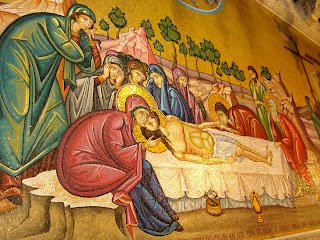I’m officially closing in on the last week of my time here
in Jordan. In some ways, it seems
like I was just throwing my things into my suitcase. Still, when I think about all I’ve seen and accomplished,
it’s hard to believe that it’s only been 10 weeks! But more on final impressions to come…
To take advantage of our last weeks here, we traveled across
country lines last weekend, arriving in the middle of Jerusalem’s Old City by
midday on Friday. After hearing
warnings of long, complicated passages from Jordan into Israel, we were
prepared to spend up to 5 hours at the border. Fortunately, this wasn’t the case, and we were quickly on
our way to the Citadel Hostel, where we spent 2 nights for only $33. I challenge anyone reading this to find
a better deal.
Sawyer and Jordan getting settled in the hostel lobby
We hit the ground running and spent the afternoon exploring
all 4 quarters (Muslim, Christian, Jewish, and Armenian) of the Old City, which
is contained within towering walls.
The Muslim quarter was the largest and most crowded by far. It closely resembled the parts of the
Arab world that we’ve explored so far, and we were able to practice our Arabic
in its shops. The Christian and
Jewish quarters are roughly the same size, followed by the tiny Armenian
quarter, which is home to some of the Old City’s first residents. The boundaries between each of the
quarters are loose, which means that people of the 3 most prominent world
religions are in constant contact with one another. Considering the tight intersection of these faiths, it’s not
surprising that the region faces constant conflict. Nowhere else is home to so much history, nearly all of which
holds significance for multiple groups of people.
Throngs in the Muslim Quarter
Winding through the various quarters, we walked the Via
Dolorosa, which follows Jesus’ path from the time of his condemnation to his
crucifixion and burial. Along the
walk, there are 14 Stations of the Cross, marking different points throughout
the streets where Jesus supposedly carried the cross. Pilgrims come from around the world to walk this route, and
Jerusalem profits from it. It may
be the only city where you can, in fact, rent a cross to carry as Jesus
did. We opted out of this option,
but the experience was still powerful.
It ended in the Church of the Holy Sepulcher, where a throng of people
waiting to kneel before Jesus’ tomb.
No sooner had we entered the space, though, when one of the brothers
ushered us out to make room for the others seeking holiness.
Inside the Church of the Holy Sepulcher
We ended our first evening with a visit to the Western
“Wailing” Wall, one of the most significant sites in the Jewish tradition. Since it was Friday night, we arrived
just in time for the first Shabbat celebrations, complete with plenty of
singing and dancing. Quite the
party!
The Western Wall before Shabbat. Men on the left, women on the right.
Day 2 was even more action-packed than the first, so I’ll
try to give a quick summary here.
It began with a walking tour of the Old City, followed by a trip to the
Garden Tomb, another sight where Jesus may have possibly been buried. Experts have speculated about this site
for a little over a century, which makes it much more recent that the tomb in
the Church of the Holy Sepulcher.
It was fascinating to see the contrast between the two tombs. Whereas the Roman Catholic, Eastern
Orthodox, and Oriental Orthodox Churches share the Holy Sepulcher, the Garden
Tomb traditionally means more to Protestants. As a result, the older site was elaborately decorated and
closely policed, whereas the newer one was simple and quiet.
Inside the Garden Tomb
From the Garden Tomb, we took a bus to Bethlehem, to see where
Jesus was born. Situated in the
Palestinian West Bank, the birthplace is no longer a peaceful barnyard
scene. Rather, it’s a point
surrounded by yet another elaborate church in the middle of a busting
city. Maybe not what you picture
in church on Christmas Eve, but real and captivating all the same.
The place where Jesus was supposedly born. I bet it didn't look like this then!
Then, we were back to Jerusalem, where we walked along the
ramparts of the Old City’s walls.
Fantastic views, a cool breeze, and the chance to imagine guards
patrolling centuries in the past.
It was a great was to reflect on the day and appreciate Jerusalem’s
beauty.
Walking the ramparts
On Day 3, our final day, we rode to the top of the Mount of
Olives and walked down to the Garden of Gethsemane, where Jesus spent his last
evening praying. In contrast with
many of the biblical sites that we saw, this garden was natural and
serene. It was easy to imagine the
garden, filled with olive trees and flowers, as a place for final
contemplation. Altogether, it was
a fitting place to end our journey to Jerusalem and begin our travels home.
Olive trees in Gethsemane
This trip was so full that it’s difficult to capture every
moment in a blog post, but I hope I’ve given everyone an idea of what we
saw. It was an incredible
experience, one that left plenty of room for reflection on history and current
interfaith relationships.
Sunset views of the Old City
In a little over a week, I’ll be landing in Atlanta. As a result, this may be my last post
from the Middle East, but I’ll try to wrap it all up at some point soon. Until then, enjoy the rest of your
summer, and I’ll hope to see you state-side!









No comments:
Post a Comment